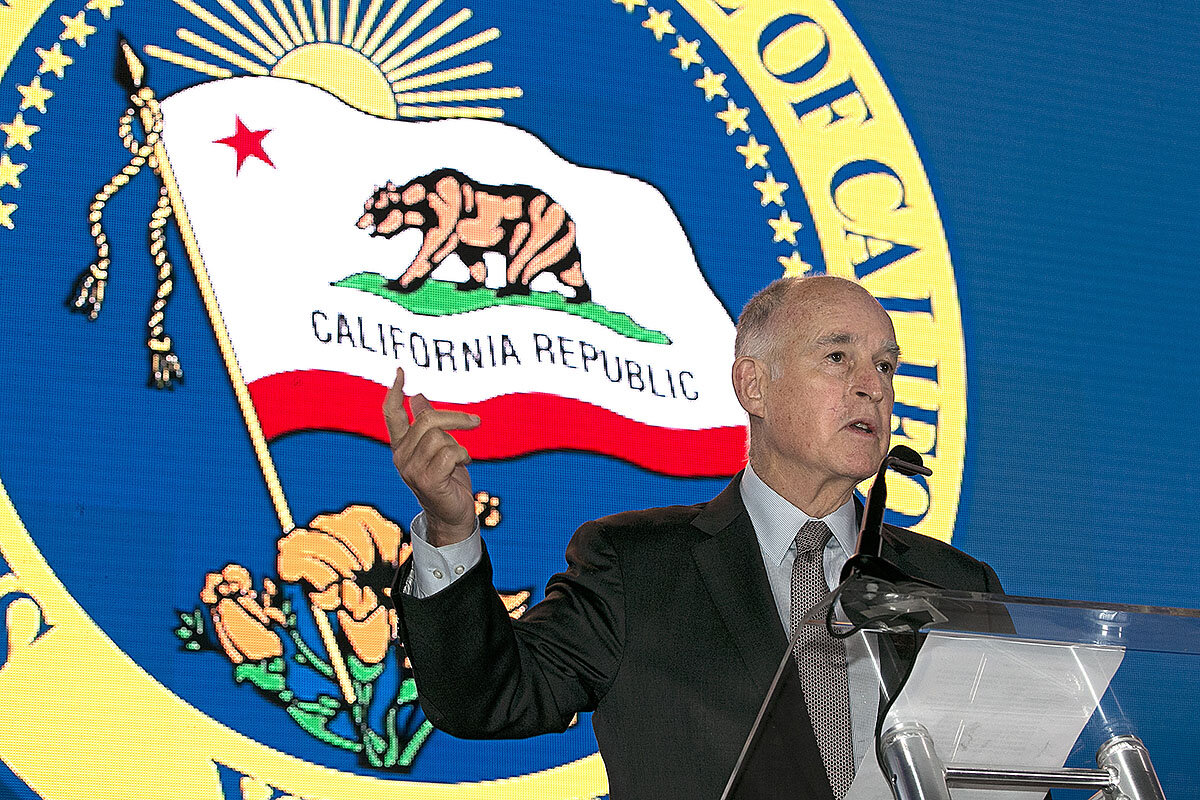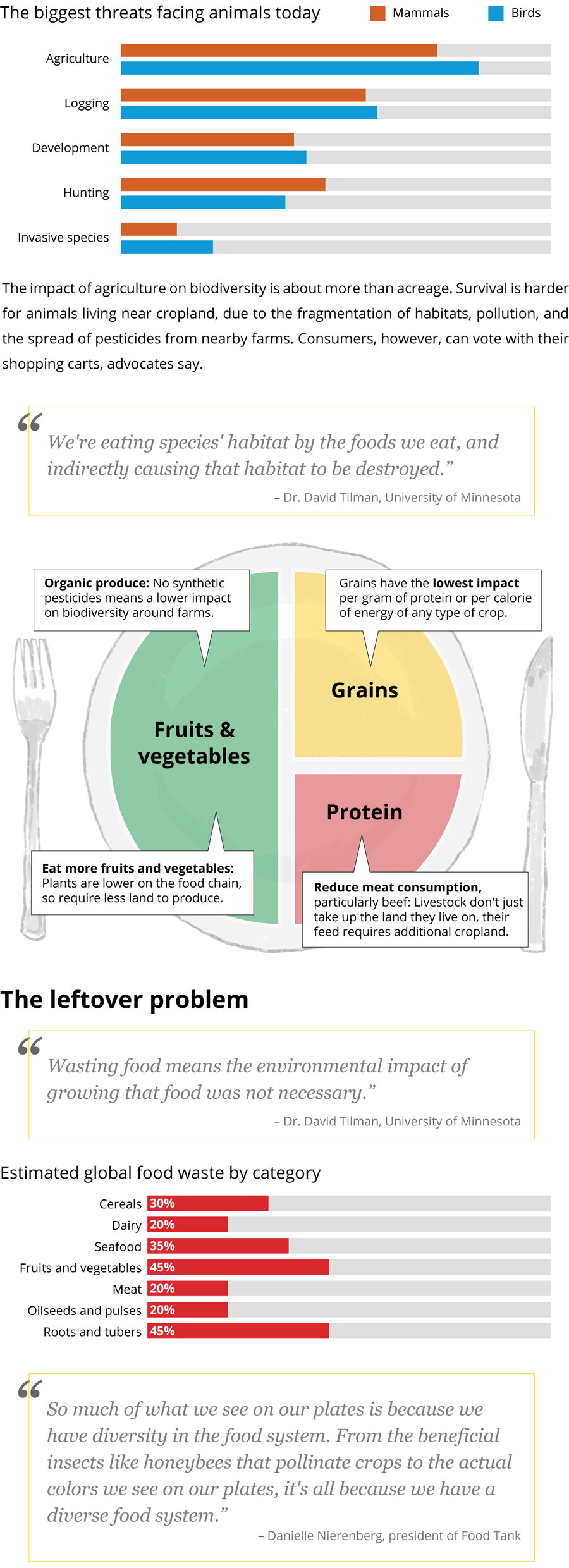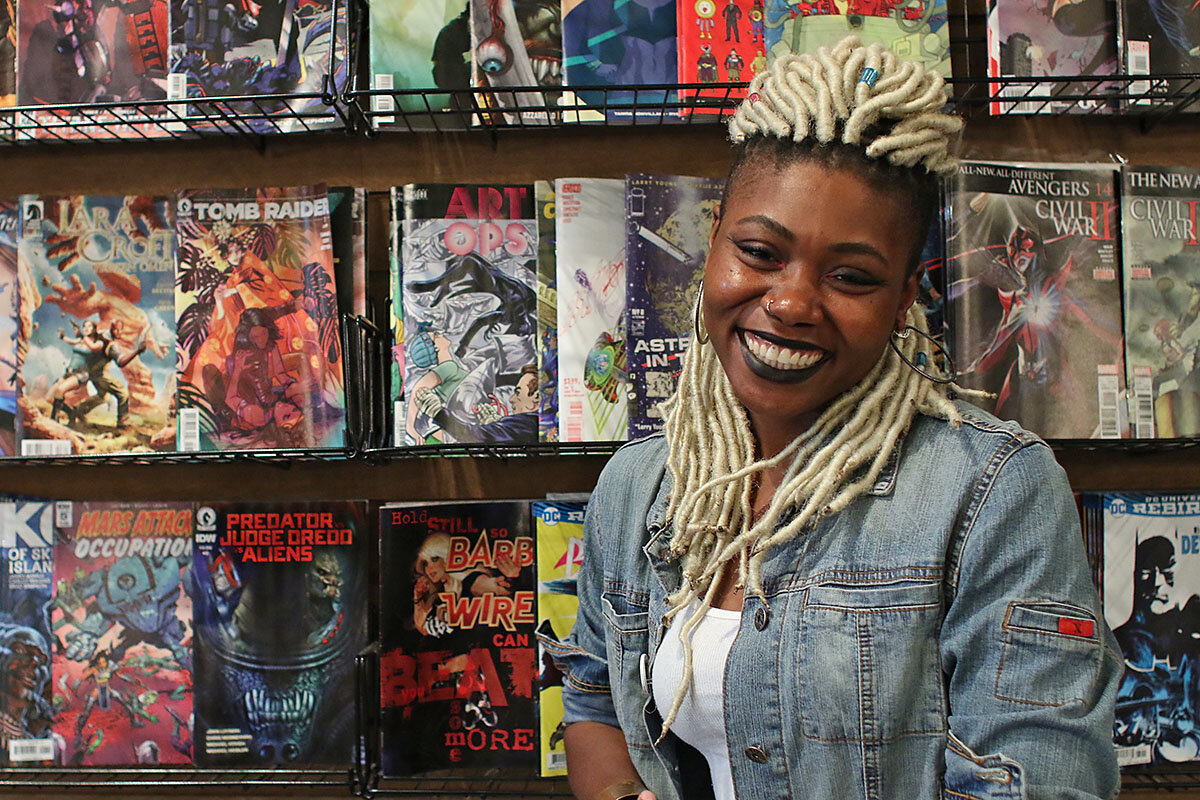- Quick Read
- Deep Read ( 6 Min. )
Monitor Daily Podcast
- Follow us:
- Apple Podcasts
- Spotify
- RSS Feed
- Download
TODAY’S INTRO
Monitor Daily Intro for June 2, 2017
Some weeks you need a calculator with your news.
New job numbers came out Friday. They’re up (though not as much as expected) and unemployment is down (to 4.3 percent, its lowest rate since 2001). That could open the way for the Federal Reserve to raise interest rates when it meets June 13.
On Thursday the US Census put out a major report on inequality. A black/white gap in personal wealth, which had widened in the recession, narrowed from 2011 to 2013. And net worth grew for those in the middle-income range (though not as nearly as much as in the top fifth).
Who’s up, who’s down? Anecdotes can be richer than indicators. On Wednesday, The Wall Street Journal looked at gender equality at large firms. Women remain vastly outnumbered in corner-office jobs. But last year, 21 women chief executives got a median compensation package of $13.8 million, compared with $11.6 million for the 382 men in that position.
The little guy may have made out this week, too: The US Supreme Court just ruled in favor of a small aftermarket player in the printer-toner business in its long battle with a cartridge-maker who’d sued it for selling cheap refills. That promises to help companies that resell or repair other companies’ products – and to give consumers greater choice.
Taken together, that looks like a tapestry of progress. Now, here are five stories for your Friday.

Help fund Monitor journalism for $11/ month
Already a subscriber? Login

Monitor journalism changes lives because we open that too-small box that most people think they live in. We believe news can and should expand a sense of identity and possibility beyond narrow conventional expectations.
Our work isn't possible without your support.
Paris pullout: Now, US cities and states respond
Even as the global press and public wrestled with the implications of President Trump’s withdrawal from a widely embraced climate accord, a handful of cities and states vowed to adhere to its terms. As Peter Grier explains, that could be more than symbolic.

-
Jessica Mendoza Staff writer
-
Henry Gass Staff writer
American leadership doesn’t live only in Washington. Perhaps that’s one of the implications of a growing backlash of US states, cities, and companies against President Trump’s decision to withdraw from the Paris global climate accord. This loose coalition says it will try to plan ways to meet US greenhouse gas emission targets set by the Paris pact, whatever the White House says. This could mean switching police cars to natural gas, levying carbon taxes at the state level, or switching truck plants to all-renewable energy. Mr. Trump says Paris is a “disaster” that could cost America millions of good jobs. This new opposition, which includes Republican as well as Democratic governors, sees it as an opportunity to build new jobs around the work of adapting to what will come. “These are not tree-huggers,” says one environmentalist.
Paris pullout: Now, US cities and states respond

President Trump’s historic decision to withdraw from the Paris global climate accord has produced an extraordinary reaction from a group of US states, cities, and corporations opposed to the move. They’ve banded together in a loose coalition that intends to try and meet US greenhouse gas emission targets set by the pact, despite official Washington policy.
Does American leadership always reside in the White House? That’s a question to which the US Climate Alliance – which includes the governors of at least four states, dozens of mayors, and more than 100 corporations – may provide at least a partial answer.
“I have to say, the president’s short-sightedness and just offensive breaking of a promise that this country made with the rest of the world is really inspiring others to step forward into the void of leadership that he has left," says Libby Schaaf, the Democratic mayor of Oakland, Calif, in a phone interview. “I believe in some ways his action is going to inspire more philanthropists, more industrial leaders to come out and say, ‘We as Americans are not breaking our promise.’ ”
There’s partisanship in this action, of course. But it is also driven by a concern on the part of many non-national officials and executives – including some Republican leaders – that the United States needs to keep its eye on building new jobs and industries around the work of adapting to a changing global environment.
“These are not tree-huggers,” said Mindy Lubber, president and chief executive officer of Ceres, a sustainability advocacy group, in a phone briefing Thursday organized in support of the new coalition.
That said, some of the biggest names in the nascent organization are politicians long opposed to the Trump administration’s America First approach to world affairs. They include Michael Bloomberg, the former New York City mayor and billionaire, Andrew Cuomo, the Democratic governor of New York State and possible 2020 presidential candidate, and Jerry Brown, Democratic governor of California. New York and California – together with the states of Washington and Connecticut, which have also signed on – represent nearly one-quarter of America’s gross domestic product (GDP).
“Donald Trump has absolutely chosen the wrong course. He’s wrong on the facts,” said Governor Brown on the Thursday phone call, which was organized by the World Resources Institute.
The new group is trying to determine if it can submit a greenhouse-gas emission reduction goal to the United Nations alongside those submitted by almost all the world’s sovereign nations. Given the size of the California and New York economies it is possible this goal could approach the one pledged by former President Barack Obama of a 26-28 percent reduction in emissions by 2025, measured against 2005 levels.
It’s the 26 percent reduction goal, itself non-binding, that Mr. Trump has said that the US will no longer take steps to meet, during his administration.
Why companies are getting greener
But politics isn’t the only reason for the new group’s formation. It also reflects the fact that many states and localities have already taken steps to try and reduce emissions, under voter and corporate pressure.
About 30 states have already adopted mandates that require utilities to reduce their use of fossil fuels and increase use of renewable energy, for instance.
Corporate leaders also see green energy as an aspect of many developing industries and possible marketing tool. They don’t want to cede leadership in this area to competitors such as China. Many lobbied Trump to stay in the Paris agreement and were unhappy when he withdrew.
“Disappointed with today’s decision on the Paris Agreement,” tweeted Jeff Immelt, chairman and CEO of General Electric, following Trump’s announcement. “Climate change is real. Industry must now lead and not depend on government.”
The world is now moving in a different direction than the US on the environment, and if US companies don’t move with their global competitors they will be left behind with primitive technologies and primitive manufacturing processes that won’t match up in the years ahead, says William Rees, an ecological economist at the University of British Columbia.
Boosting oil and gas production and attempting to revive the coal industry is 19th -century thinking, says Professor Rees. That won’t work for companies that want to maintain global market share in the 21st century.
“No corporate entity that has an international status is going to want to climb onto a 19th -century bandwagon, and that’s what Trump and his people represent,” says Rees.
Not just happening in the Arctic
Meanwhile, it is states and cities that are already being forced to deal with the realities of climate change on a practical level. This includes not just East and West Coast cities dealing with rising oceans but Middle American places like South Bend, Ind.
Last August South Bend had one of the most devastating storms in its history, says Mayor Pete Buttigieg, a Democrat who made a brief run for the leadership of the Democratic National Committee earlier this year. Seven inches of rain fell overnight. Families had their homes destroyed by rainfall and flash flooding.
“We have to stop thinking of climate change as something that happens in the Arctic, and recognize it as something that’s impacting us at home,” says Mr. Buttigieg.
South Bend is now reengineering its sewer systems as a “green infrastructure” that can handle increased rainwater. It’s revising its city forestry plan to include trees better fitted for a changing climate. It has retrofitted police cars and other city vehicles to run on natural gas, and optimized traffic lights to reduce idling times.
“This is one of the many issues where the federal level of politics has let us down, and when that happens it’s increasingly fallen to cities to step up and take a leadership role,” Buttigieg says.
On the other hand, Tom Pyle, president of the American Energy Alliance, says the federal level did not let down US voters in this instance. Trump was right to withdraw from the Paris agreement, he says.
Many of the adjustments away from fossil fuels made at the city and corporate levels are the result of onerous regulations that the Trump administration is now in the process of unwinding, he says. And the Paris agreement carried a real cost for US taxpayers. The US had pledged up to $3 billion in aid for poorer nations to make their own investments in renewable energy. (Of that amount, $1 billion has been paid.)
That’s money that the GOP-controlled Congress was not going to authorize, Pyle points out. Given all that, “there is really no reason to be in the agreement at all,” he says.
A determination to do more
It’s unclear whether the pro-Paris group of non-federal government and businesses can earn any sort of official standing with the UN overseers of the climate agreement. The accord was designed around nation-states, not ad hoc groups of concerned organizations.
But even a separate pledge would indicate that leadership in the US has passed to different levels and progress is being made, according to former New York City Mayor Bloomberg and other leaders of the effort.
That could counteract one of the biggest worries of environmental groups: that the US action could spark an “us, too” reaction among other nations. The thinking would run along predictable lines. The US isn’t going to participate. Why should we?
This sort of thinking could trickle down to the individual level of mayors and companies both in the US and around the world, says Timmons Roberts, a professor of environmental studies at Brown University in Rhode Island.
But “that’s not what I’m seeing now,” he says. “I’m seeing a defiance and grim determination to do more.”
Staff writers Noelle Swan and Eva Botkin-Kowacki contributed to this report.
Share this article
Link copied.

In Arab countries, a delicate test of reintegration
Can societies with deep-seated cultural biases regarding women learn to see them as individuals with their own sentiments and motivations – both for better and for worse? Taylor Luck writes about what the effect of such an evolution in thought could mean in confronting the ISIS threat.

- Quick Read
- Deep Read ( 6 Min. )
-
By Taylor Luck Correspondent
For years, the role of women in Islamic State (ISIS) has been marginalized or trivialized by the press and public. In both Western and Arab media, women frequently are portrayed as “victims” who have been “brainwashed” by influential men. Yet experts say the true reason behind women’s allegiance to ISIS is much simpler: They are true believers in the jihadist cause. And, they warn, unless states overcome cultural biases that often pardon women and overlook their political grievances, they may soon face imminent security threats. ISIS has put women front and center, relying on them for propaganda, logistics, policing, and attacks. Women have been suicide bombers in Syria, Libya, and Turkey. In the past year, female would-be bombers were arrested in France, Morocco, and Indonesia. “The idea of women being violent is very difficult to accept,” says one expert. “Women who join militant groups are seen as sociopaths, as damaged,” she says. “Society promotes the idea that we can make her human again by reminding her she is a woman – marry her off and encourage her to start a family.”
In Arab countries, a delicate test of reintegration

One thing drove university graduate Emna from abandoning her middle-class life in Tunisia to carry the so-called Islamic State’s banner in neighboring war-torn Libya.
She was not swayed by some suave jihadi, she says, not running away from a broken home, nor a repressed life or poverty – nor any of the other rationales that have been supplied to explain women’s participation in ISIS’s brutal jihadist campaign, which has generated countless stories of beheadings, massacres, and sexual slavery.
She joined for one simple reason.
“I wanted to defend Sunni Muslims,” says Emna, using her nom de guerre, via Skype from Tunisia.
Yet unlike the estimated 200 or so male ISIS recruits who have returned home to Tunisia from foreign battlefields, the 24-year-old has not faced prison time.
For nearly three years, the role of women in ISIS has been marginalized or trivialized by the press and public.
In both Western and Arab media, women frequently are portrayed as “victims” who have been “brain-washed” by influential men. More salacious claims, particularly in the Arab press, are that many women join ISIS to marry and have sexual relations with fighters in so-called jihad al nikah, or sexual jihad.
Yet experts say the true reason behind women’s allegiance to ISIS is much simpler – and darker: They are true believers in ISIS’s cause.
And, these experts warn, unless states in the West and the Arab world overcome cultural biases that often pardon women and overlook their political grievances – biases that ISIS, which increasingly relies on women, deliberately exploits – they may soon face imminent security threats.
Willing warriors
There are no precise figures for the number of women who have joined ISIS. Various estimates suggest some 10 percent of Western recruits are women, while thousands more have joined the group from Arab states such as Saudi Arabia, Tunisia, Jordan, Syria, and Iraq.
While its jihadist rival Al Qaeda, a branch of which gave rise to ISIS, often relegated women to raising “the next generation” of jihadist children, ISIS has put women at the front and center, relying on them for propaganda, logistics, policing, and attacks.
“We are seeing a shift in women jihadists from acting as support to becoming active fighters in their own right,” says Hassan Abu Haniya, a Jordanian expert in jihadist movements.
None have had a bigger role than the all-women Khansaa Brigade, the female police force that imposes ISIS’s laws and edicts in Syria and Iraq and that has been accused of the torture and forced disappearance of women.
But women are involved in more than just police work.
ISIS is believed to have deployed its first woman suicide bomber during the battle against Kurdish forces for control of the northern Syrian city of Kobani in late 2014. Since then, it has deployed women as suicide bombers in Libya and Turkey, while female would-be suicide bombers were arrested in France, Morocco, and Indonesia over the past year.
Women have proven to play key roles in planning ISIS attacks in Paris, Jordan, and Turkey.
Cultural attitudes
Yet security services’ monitoring, tracking, and investigating of women as potential ISIS members faces several logistical and cultural barriers.
One is that women in conservative Muslim societies are often shielded, and mingling with male strangers – even policemen or security agents – without the presence of a male relative is considered taboo, and even shameful.
Security experts say ISIS is exploiting these sensitivities, relying increasingly on women, who due to their cultural standing and traditional concepts of family “honor” are much more difficult to track.
“We can’t just go door to door and lift the veil of every woman, or monitor all women’s schools and cafes,” says a Jordanian security source. “That would cause a riot.”
“The community has to play a large role in this, because they can go where sometimes we can’t.”
Other security sources say that in more conservative societies such as Saudi Arabia, where women must obtain the permission of male guardians to travel, to even suggest that a woman joined an extremist group would be seen as expressing a “criticism of the family” and therefore fiercely rejected.
“We treat women daesh [ISIS] members just as seriously as men – but we have to be careful with certain sensitivities,” says an official affiliated with the Saudi Interior Ministry who requested anonymity due to the sensitivity of the subject.
Why they fight
Experts say states – both Arab and Western – need to change their attitudes toward women fighters, one away from victimization, which overlooks and denies the real political grievances that drive women to join extremist groups such as ISIS.
“The idea of women being violent is very difficult to accept in these societies and even in Western societies,” says Nimmi Gowrinathan, professor at the Colin Powell School for Civic and Global Leadership in New York and an expert in women in armed groups.
“Women who join militant groups are seen as sociopaths, as damaged,” says Professor Gowrinathan. “Society promotes the idea that we can make her human again by reminding her she is a woman – marry her off and encourage her to start a family.”
Multiple women interviewed remotely by the Monitor through messaging apps and third parties say they had similar reasons for joining ISIS: to defend Sunni Muslims from the Syrian regime, to fight Iran and the West, to live under what ISIS claims is Shariah law.
Many said they were motivated by real crises in the region: the war in Syria, the Israeli-Palestinian conflict, the growing influence of Iran – all exacerbated by their inability to have a political voice at home.
Rather than being recruited, they sought out ISIS as true ideological converts.
The narrative of women as “victims” rather than politically motivated actors is one that is championed and pushed by the families of women who have joined ISIS as they lobby for their return and for states to pardon them.
“We see these young men and women as victims, they are tricked and allured,” says Mohamed Iqbal of the Rescue Association of Tunisians Trapped Abroad, an advocacy group for families of men and women who have left to join jihadist groups.
According to experts, however, as a result of misconceptions over why women join militant groups such as ISIS, states and NGOs have been taking the “wrong approach” to reintegrating them into society.
Many Arab states leave it to communities to reintegrate ISIS women, while international NGOs carrying out DDR (disarmament, demobilization, and reintegration) programs offer sewing machines and household income-generating projects, cementing their “feminine identity.”
“As for women, it is as if we are going to take them from 2017 and take them back to the 1950s, and that would solve their underlying political grievances,” says Gowrinathan.
Lenient sentences
But security experts and residents point to an even greater obstacle than policing: lenient sentences.
Often due to lobbying from families and public sympathy for women viewed as victims, states across the Middle East have handed down shortened sentences or pardons for women who have joined ISIS – even those who may have blood on their hands.
In Saudi Arabia, where, according to official accounts and experts, women have played an active role in recruiting and planning attacks, the kingdom’s harsh penal system has been unusually lenient.
In May 2016, a 27-year-old woman convicted of joining ISIS and encouraging attacks on Saudi security services over social media was handed down a reduced prison sentence – three years instead of six. Other women convicted of belonging to ISIS have been sentenced from two to four years.
In Tunisia, dozens of women who either were prevented from leaving the country to join ISIS or have returned have been held briefly without charge.
In Jordan, dozens of young women who have been turned back attempting to enter Syria and join ISIS from Turkey have been pardoned, without spending a single day in prison.
Their sentences pale to those of young men in Jordan, who often are sentenced for five years just for a Facebook post sympathizing with ISIS, or in Tunisia, where young men can face two years in prison before they even go before a judge.
Experts say many of the dozens of women returning from Syria or leaving prison are ideologically motivated and are unlikely to shed their extremist views without extensive rehabilitation – support that is unavailable in the Arab world.
“Women jihadists have proven themselves as capable fighters, ideologues, and recruiters,” says Abu Haniyah.
“To underestimate or neglect women jihadists would be a huge mistake for security services across the region – and one they may pay for in the near future.”

Human trafficking: Voices from the road back
For Monitor photographer and videographer Ann Hermes, a week in Cleveland recording the stories of women who had confronted – and were overcoming – manipulation, kidnapping, physical abuse, and drug addiction was transformative. What she picked up on: a lack of public understanding about human trafficking. “The most persistent misconception I heard was that it doesn’t happen in the United States,” she says, “and that prostitution is always a choice – as opposed to a lack of choice.” Ann also found reasons for hope. “Once these victims find their footing,” she says, “they can become advocates, helping others like themselves through the recovery process.”
Hope for Human Trafficking

A shopper’s guide to preserving biodiversity
A lot of what we hear and read about environmental action comes from a policy or industry standpoint. But, as readers often remind us, action can be personal, and effective – if individuals know what they can do. We used that thinking to shape this story.
The sheer number of species disappearing entirely from the wild has prompted many scientists to dub the current era Earth’s sixth mass extinction event. Vertebrate species are becoming extinct 100 times as fast as the background rate of extinction. That surge has largely been linked to human land use. So can humans find a way to share the planet with its other inhabitants? University of Minnesota ecologist David Tilman addressed that question in a paper published this week. Habitat loss, particularly due to agriculture, is a significant threat, scientists say. “Of all the land that is suitable for humans and most other animals, 40 percent is already in agriculture,” which is uninviting for most wildlife, Dr. Tilman says. So if humans can be fed on less land, more land will be left for biodiverse habitats. But it's not just up to the agriculture industry to increase the amount of food produced per acre, scientists say. Everyone eats, so individuals can make food choices that require less land to produce.

UN Food and Agriculture Organization, 'Future threats to biodiversity and pathways to their prevention' Tilman et al., Food Tank, World Resources Institute

What ‘Wonder Woman’ says about an art form’s followers
Forget what you think you know about comic-book fans – and about the way “power” tends to be distributed in that universe. We’ll leave you with Molly Driscoll’s thought-shifting piece as the weekend of “Wonder Woman” kicks off.

- Quick Read
- Deep Read ( 6 Min. )
Superman has been leaping tall buildings since the 1970s, but it took 76 years for Wonder Woman to make her big-screen debut. The new “Wonder Woman” also features something harder to find than an invisible plane: a woman, Patty Jenkins, directing a big-budget superhero movie. Alisa Perren, coauthor of “The American Comic Book Industry and Hollywood,” believes this is because of outdated attitudes about who reads comic books and watches movies featuring loners with unusual abilities. More of them are like Ariell Johnson, owner of Amalgam Comics & Coffeehouse in Philadelphia. “When I go into comic book stores, I would often be the only black person or the only woman in the space and that can be intimidating,” she says. “My goal with the shop is to make sure no one ever feels like that coming in.” Ms. Johnson says she works to showcase a selection of books that “is really representative of the population of people who read comics.” She says that’s easier than ever with characters like Kamala Khan, the new Ms. Marvel, and Miles Morales, an Afro-Latino Spider-Man. “You feel like you matter,” Johnson says.
What ‘Wonder Woman’ says about an art form’s followers

Ariell Johnson had been a fan of TV shows like “He-Man and the Masters of the Universe,” “She-Ra: Princess of Power,” and “Thundercats” – “things with superpowers and enchanted weapons and things like that,” she says. But when she began watching the “X-Men” TV series that aired beginning in 1992 on the Fox Network, she experienced a first.
“Through that cartoon, I was introduced to Storm,” Ms. Johnson says. “I had never seen a black woman represented in those genres.”
Storm, a superhero who controls the weather, inspired Johnson to begin reading comic books. Today, she’s the owner of Philadelphia’s Amalgam Comics & Coffeehouse.

“When I go into comic book stores, I would often be the only black person or the only woman in the space and that can be intimidating,” she says of her decision to open her establishment in 2015. “It can be uncomfortable and depending on the type of store you're in, it's not always a positive experience because people can be hostile to you because of those differences…. My goal with the shop is to make sure no one ever feels like that coming in.”
Johnson is one of a growing number of female comic book readers snapping up comic books like Muslim author G. Willow Wilson's "Ms. Marvel" series starring Kamala Khan. While Nielsen-like numbers are hard to come by, a November 2015 report by the website Graphic Policy intrigued many when it reported that women made up more than 51 percent of the people who said they were comic book fans on Facebook.
Meanwhile, Storm, played by Oscar winner Halle Berry, got her big-screen debut in 2000’s “X-Men.” It would take 17 more years for the first, and most iconic, female superhero, to get her own movie. “Wonder Woman” opens Friday to Amazonian-sized expectations.
Superman has been leaping tall buildings since the 1970s and comic book movies have been reliable (if not infallible, see: “Green Lantern” and “Fantastic Four,” any version) blockbusters for decades. But it took 76 years for Wonder Woman to make her big screen debut. Alisa Perren, co-author of the forthcoming book, “The American Comic Book Industry and Hollywood,” suggests this is due to outdated attitudes about who reads comic books and watches movies featuring loners with unusual abilities.
“[There’s] this sort of primary emphasis on young male audiences as the sort of focal point as well as the perception, whether legitimate or not, that those are the primary readers and consumers, which much of the data indicates is less and less the case for comic properties and crossover properties…,” says Dr. Perren, who is also associate professor in the department of radio-TV-film at the University of Texas, Austin. “The perception is more that the men will bring the women along but the women won't bring the men along.”
For the most recent Marvel film, May’s “Guardians of the Galaxy 2,” 44 percent of the audience who went to see the movie in its opening weekend were women. And in 2014, Publishers Weekly said the fastest-growing audience for comic books was women ages 17 to 33.
While female characters like Guardians’ Gamora, X-Man Storm, and Avenger Black Widow have been part of world-saving ensembles, the last woman to helm a superhero movie was Jennifer Garner in 2005’s “Elektra.” “Wonder Woman” also features something harder to find than an invisible plane: a woman, Patty Jenkins, directing a big-budget superhero movie.
“We have a female carrying a large tent-pole film, which is extraordinary,” Stacy Smith, a professor at the University of Southern California who studies diversity issues in Hollywood, told the Los Angeles Times. “‘Wonder Woman’ is absolutely a step in the right direction.”
Perren says that fairly or not, “Wonder Woman” will serve as a test case for many Hollywood executives.
“I feel like we have all these stories and narratives starting to form and decisions that are like waiting to be made based on what happens with it,” she says. “Which unfortunately is the history of these very rare occasions when women have leading roles in front of or behind the camera, that one property and its success is then extrapolated to be evidence of viability writ large. Whereas that doesn't happen, of course, when ‘Green Lantern’ fails.”
Overall, the comic book universe – in print and on screen – is clearly becoming more diverse. Other big-screen projects putting people of color and women front and center are 2018’s “Black Panther” starring Chadwick Boseman, 2018’s “Aquaman” starring Jason Momoa, and 2019’s “Captain Marvel” starring Brie Larson. Perren says that TV has done a better job of showcasing female and minority characters, such as ABC’s “Agents of S.H.I.E.L.D.” and Netflix’s “Jessica Jones” and “Luke Cage.”
When Iron Man is a teenage girl
But the comic books themselves have gone further than their onscreen incarnations. Take Marvel, for example: Iron Man is actually now a black teenager named Riri Williams, and Spider Man is an Afro-Latino teen named Miles Morales.
Not all fans have reacted with joy at seeing a female Thor wielding Mjolnir, the magical hammer. Besides the predictable outrage of certain segments of social media, a Marvel executive said this spring that the publisher’s emphasis on diversity was hampering sales.
“What we heard was that people didn't want any more diversity. They didn't want female characters out there,” Marvel vice president of sales David Gabriel said in an interview. “That's what we heard, whether we believe that or not. I don't know that that's really true, but that's what we saw in sales.”
He later walked back the comments, saying, “Let me be clear, our new heroes are not going anywhere! We are proud and excited to keep introducing unique characters that reflect new voices and new experiences into the Marvel Universe and pair them with our iconic heroes."
Jesse Farrell, manager of Hub Comics in Somerville, Mass., agrees with those who said that there is far more to the story behind the sales numbers than just diverse characters.
“There has been a general dissatisfaction with Marvel in the last couple of years and I think it has more to do with increasing prices, brand dilution, a cycle of cancellation and restarting new No. 1s,” he says. “And every time they do that, there’s a brief bump up in sales but we also sort of lose longtime readers every time they do a relaunch.”
He does see a disadvantage in the way some of these characters are presented, however. When someone like the African-American Sam Wilson becomes Captain America, he is taking over for the white Steve Rogers.
“What I’m sometimes afraid happens is that people are just waiting for the ‘real’ Captain America to come back and take the role over again…,” he says. “I think that sometimes, what happens is these characters sort of take on the mantle of other characters for a while and then kind of get relegated to second-class character status again. That said, I think it's great that they have been doing a lot more to create more diverse characters.”
He points to the character of Ms. Marvel. “When it's done well, I think it’s great,” Mr. Farrell says.
Beyond Marvel and DC
Johnson, for one, feels that “if you enjoy a medium, you should see yourself reflected in its pages…. I think it’s awesome that Marvel is listening to their customers.”
And Johnson points out that while Marvel and DC are likely the most well-known comic creators, she has been particularly impressed by works including those by Stranger Comics, which publishes stories about Niobe Ayutami, a black elf, and the “Tuskegee Heirs” series by Marcus Williams and Greg Burnham, which is a crowdfunded series about African-American pilots.
“It sells out every time,” she says of “Tuskegee Heirs.”
“I work really hard to have a selection of books that are created by diverse creators and also showcase diverse characters and is really representative of the population of people who read comics,” Johnson says.
And with these new characters, she says that population is feeling seen. “You feel like you matter,” Johnson says.
Other headline stories we’re watching
(Get live updates throughout the day.)The Monitor's View
Why the US must support corruption fighters
- Quick Read
- Deep Read ( 3 Min. )
-
By The Monitor's Editorial Board
On June 7, corruption fighters from Afghanistan, Angola, Guatemala, Malaysia, and Ukraine will be honored by the National Endowment for Democracy, a nonprofit set up by the US government in 1983. The message: Such activists are not alone in their struggle. The work of these five – who range from an investigative journalist to a whistle-blowing judge – often comes with death threats or other pressure to back off. And that’s the point of the event: The US as well as other countries must keep a close eye on countries with high levels of corruption, to help keep those places from erupting in war or street violence. More than half the world still lives in places where people must decide almost daily whether to pay a bribe to a government official for a basic service or to avoid a hefty fine. They need help in breaking a cultural acceptance of corruption as the norm. That starts with support for the courageous few who stand against it.
Why the US must support corruption fighters

In a rare display of bipartisanship in the House on June 7, Republican Speaker Paul Ryan and Democratic leader Nancy Pelosi will speak at an event on a topic that easily unites the world: preventing corruption. They will be honoring five corruption fighters from Afghanistan, Angola, Guatemala, Malaysia, and Ukraine. The message from the United States: Such activists are not alone in their brave struggle.
The five, who range from an investigative journalist to a whistle-blowing judge, are receiving awards from a leading promoter of democratic values worldwide, the National Endowment for Democracy, a nonprofit set up by the federal government in 1983. The work of these anti-corruption activists often comes with death threats or other pressure to back off. And that’s the point of the event: The US as well as other countries must keep a close eye on countries with high levels of corruption, lest those places erupt in war or street violence. One example: Syria, which descended into war after its 2011 anti-corruption, pro-democracy protests.
The US has long given aid to countries, such as Mexico, to beef up their anti-corruption capabilities. Secretary of State Rex Tillerson supports such efforts, saying the US must “put obligations” on countries to reduce corruption. US aid not only advances America’s values, he says, but can help a country “continue its journey along better governance.”
More than half the world still lives in places where people must decide almost daily whether to pay a bribe to a government official for a basic service or to avoid a hefty fine. They need help in breaking a cultural acceptance of corruption as the norm. One way to do that is to change social expectations in favor of honesty, accountability, and transparency – starting with support for the courageous few who stand against corruption.
“For corruption to be tackled effectively, people who are opposed to it have to coordinate their efforts,” write two American scholars, Ray Fishman and Miriam Golden, in a new book, “Corruption: What Everyone Needs to Know.” People must “know that others are on board with making the same change.”
“We are tentatively hopeful that demands for – and expectations of – honest government are rising in the world today,” they write. In the 12 years since the United Nations adopted the Convention Against Corruption, many more countries, from India to Romania to Russia, have experienced anti-corruption protests.
The book cites one model: the unraveling of corruption networks in Italy during the 1990s “Clean Hands” investigation. Brazil is now in the midst of a similar cleansing of its corrupt political elite, led by prosecutors and judges who understand that equality before the law must apply to everyone. China is trying a top-down approach against its corrupt Communist Party members.
Many countries have broken the non-virtuous cycle of corruption by setting up special agencies to probe such wrongdoing and to help create a tipping point in public sentiments against graft. Often foreign pressure or the lure of aid and trade makes a big difference in setting up those bodies or blocking any backlash against them. At the very least, corruption fighters should be honored.

A Christian Science Perspective
Each weekday, the Monitor includes one clearly labeled religious article offering spiritual insight on contemporary issues, including the news. The publication – in its various forms – is produced for anyone who cares about the progress of the human endeavor around the world and seeks news reported with compassion, intelligence, and an essentially constructive lens. For many, that caring has religious roots. For many, it does not. The Monitor has always embraced both audiences. The Monitor is owned by a church – The First Church of Christ, Scientist, in Boston – whose founder was concerned with both the state of the world and the quality of available news.
Tackling terrorism with prayer
- Quick Read
- Deep Read ( 2 Min. )
-
By Brian Kissock
It might seem simplistic, even naive, to say we can pray in response to terrorist attacks, but contributor Brian Kissock found prayer to be the most effective help when his stores were bombed in Belfast, Northern Ireland. Understanding God as Love, a comforter and strengthener, rather than a creator of violence or of a violent creation, is key. Relying on a God of love empowers a person to respond with love at any given moment. Kissock notes that the concern expressed and aid given by people and emergency services around the world is certainly evidence of the love we are able to express. If we can love everyone more – no matter the seeming cultural or religious divides – then we are contributing to solutions and to world peace.
Tackling terrorism with prayer
The horrific bombings in Manchester, England; Baghdad; and Kabul, Afghanistan, bring back memories of a time when my stores were bombed in Belfast, Northern Ireland, during the time known as the “Troubles.” I asked myself, as I did then, How can we respond helpfully to such atrocities?
It might seem simplistic, even naive, to say we can pray, but from Bible times to the present day there are examples of prayer bringing enlightenment and intuition that enabled folk to overcome dire circumstances and impending peril. Isaiah 41:10 states: “Fear thou not; for I am with thee: be not dismayed; for I am thy God: I will strengthen thee; yea, I will help thee; yea, I will uphold thee with the right hand of my righteousness.” Psalm 91 says, “He that dwelleth in the secret place of the most High shall abide under the shadow of the Almighty.” These and many other comforting thoughts speak of the peace, protection, and belonging people felt in a higher power and still can feel today.
Christian Science has taught me that God is Love only, rather than a God of wrath sending sickness and destruction, and that Love could never create war or violence. It is praying with the understanding that God is Love that brings peace. It helps me see man as God-created: peaceful, cooperative, loving, and concerned with welfare.
In reality, each of us is the unique reflection of God. As Jesus put it, “The kingdom of God is within you” (Luke 17:21). We each have the ability to put those loving qualities into action at any given moment. The concern expressed and aid given by the folk and emergency services around the world is certainly evidence of the love we are able to express.
The founder of the Monitor, Mary Baker Eddy, writes: “love more for every hate …” (“Miscellaneous Writings 1883-1896,” p. 389). If we can love our fellow man, everyone, more – no matter the seeming cultural or religious divides and no matter what evil or terror has been foisted on us, for revenge is never an answer – then we are contributing to world peace.

A message of love
Crushing the tools of conflict

A look ahead
Thank you for reading today, and please check in again next week. We’ll be using the occasion of a big United Nations conference on oceans to explore a question that seems especially vital right now: Can the world come together in defense of its oceans?
Note: In the introduction to yesterday’s package, we mischaracterized the Paris climate agreement. It is a nonbinding accord.




